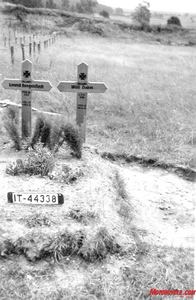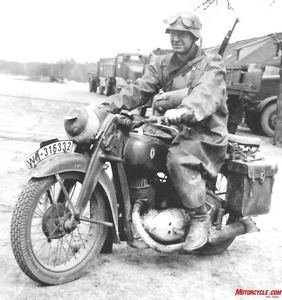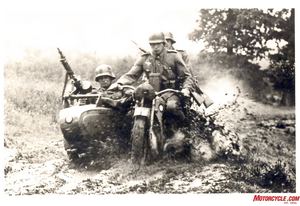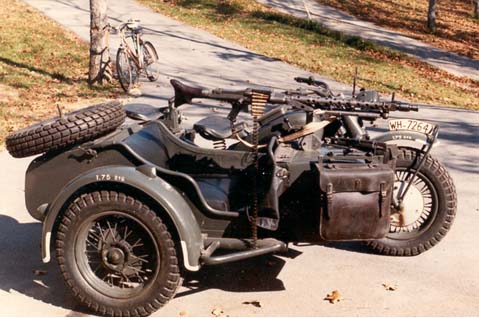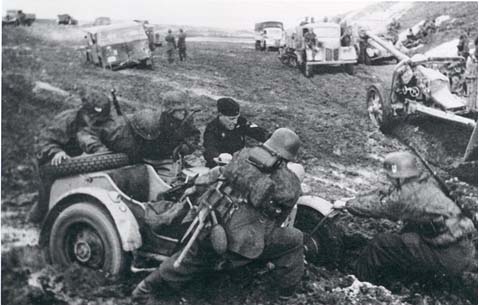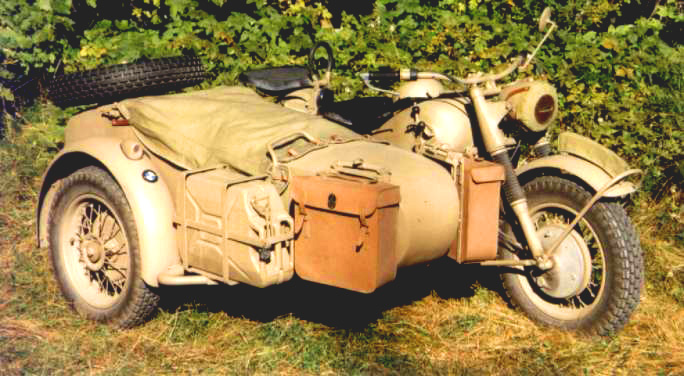Since this subject doesn’t seem to attract as much interest as it should…
(sad indeed…) I had to dig in and found an interesting motorcycle/side-car enthousiast take on the subject, to start the discussion, sort of.
Sorry about the video link in previous post, the site no longer exist (lawsuit)
Nazi Germany put some 25,000,000 individuals into uniform. Some flew in the Luftwaffe, some sailed in the Kriegsmarine, many others slogged it out in the Wehrmacht. Several thousand rode to war on motorcycles, some purpose built for combat, others conscripted from the streets of Berlin, Hamburg, Frankfurt and wherever they were roaming at the time, frequently their owners/riders finding themselves in uniform along with their bikes. While the blight of Nazi Third Reich scarred the history pages with their crimes, we, as motorcyclists, have in a way a duty to examine the German iron warhorses as part of the history of motorcycling. Motorcycles have been going to war as long as there have motorcycles around to go to war. American Harley-Davidson and Indian; British Triumph, BSA Matchless and Norton; Italian Moto Guzzi and Gilera; French Terot and Gnome Rhone; Belgian FN and Gillet. If you had a war to go to, motorcycles would get you there, oftentimes faster and through terrain inaccessible to other vehicles. The German military was the largest employers of motorcycles during World War II 1939-45. In addition, as German forces swept across conquered lands, they acquired a wide array of British, French and Belgian machines, painted them Wehrmacht gray and sent them into battle. German military motorcyclists played an important role either in solo courier or scouting capacity, as teams of tank hunters or in divisions of rifle troops.
(PICTURE 1)
Somewhere in the vastness of Eastern Russia lay the graves of two German soldiers.
The photograph seen below, perhaps taken by a comrade in arms, identifies them as members of a motorcycle rifle troop thanks to the license plate left on the grave along with the carefully placed wildflowers. The license plate was once attached to the front fender of their Zundapp, NSU or BMW motorcycle.
We can read the soldiers’ names although the original photo is now more than 65 years old. It tells us that two members of the Wehrmacht, the German military machine that blitzkrieged across Europe and into Soviet Russia, stopped here and went no further on June 18, 1942, the fateful moment when the German army reached Stalingrad, the beginning of the end for the Third Reich.
What did the German soldier think of their warhorses? One NSU rider wrote back to the company the following words of praise, often echoed by his comrades. The following quote is contained in two excellent resource books titled “Motorcycles of the Wehrmacht” and “German Military Motorcycles” by Horst Hinrichsen (Schiffer Military History series).
“On September 21, it has been five years since I bought it new at your Stuttgart branch, where I worked as a mechanic since August 1939. Since the end of August I have been in Wehrmacht service with the motorcycle, which I myself have always driven since then. During the four years of my private driving, the machine always functioned to my complete satisfaction, as it has now, since I have been drafted. In this year I have driven it 20,000 km, at first in the Polish campaign, then during service in the operational area of the western front and on duty in France. During the campaign in France I drove about 7,000 km. If possible, I want to buy back the machine after the end of the war we have been compelled to wage.”
This letter was penned in the early part of the war when Germany seemed invincible. There is no word if the satisfied customer was ever able to claim his beloved motorcycle.
On June 22, 1941 Germany launched its Operation Barbarossa, the 3-million-man invasion of the Soviet Union. During the campaigns that followed they served a variety of functions including chauffeur service for officers, delivering dispatches, even hot meals, as scouting patrols, as point vehicles taking the brunt of battle, sometimes as specially equipped tank destroyers. As with all motorcyclists, there was a kinship among these soldiers who called themselves “kradmelder.” They rode exposed without the armor plating of the Panzers, without the safety of hundreds of foot soldiers beside them. Moving targets as it were. Sniper magnets. And then there were mine fields, artillery fire, and strafing aircraft to contend with.
The other enemy was the Russian weather. By autumn the roads had turned into nearly impassable bogs, the fields over which the motorcycles traveled turning in to “seas of jelly three feet more deep.” Pack horses sank to the bellies, boots were sucked off the soldiers’ feet. Motorized forces that had once traveled over 70 miles in a day now were lucky to make 10. By winter, temperatures fell to -40 degrees, engine oil and exposed soldiers froze solid.
There were 113,000 cases of frostbite reported. Some German motorcycle riders benefited from special heating systems grafted onto their bikes, including foot and hand warmers. They, all along with the foot soldiers, ate horse meat provided by over 100,000 animals that died in the freezing cold. But the iron horses pushed on.
In an effort to improve of the design of their motorcyclists, BMW sent designers to the frontlines. One such designer reported the following. "While we were following the movement of the front in daily stages, we spend the nights in tents on the steps. We had crossed the Don, and then gone in the direction of Stalingrad, and we sought out the field repair ships, which operated in the most primitive conditions, directly behind the front line. There the machines were examined and reports on the troops’ experiences were taken. My opinion was correct. The machines went under the liquid mud, which flowed over the motors by the bucketful and was sucked into the low-lying air filter, ruining it – the mud got into the motor, and often the oilpans no longer held oil, but only sand.
One clearly saw the enormous difference between the soldiers out there on the front and the back-line people, who were real bureaucrats, while the troops were trying to build one usable machine out of 10 ruined ones. The new oil filter on my machine, screwed onto the tank high up, performed without trouble. But the improvements – although we worked on them day and night to change the whole series at once – were no longer sufficient for Russia. Stalingrad had changed everything. All the machines that went to the east were lost, at least we never heard of them again."
“By war’s end, many if not most of the motorcycles, along with their riders, never returned home.”
